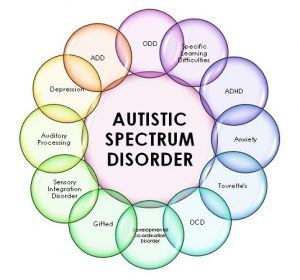71 8.1 Overview of Autism Spectrum Disorder (ASD)
What is Autism Spectrum Disorder?
Autism Spectrum Disorder is a developmental disorder that covers a complex range of conditions that compromises an individual’s behaviour socially, cognitively, and verbally. ASD usually have an early onset in development, where symptoms can be observed in children of ages 1 and 2 (APA, 2013). The severity of ASD can also range from gifted to severely challenged (Gerami, 2018). In reality, many children are not properly diagnosed until they reach older age, where a proper final diagnosis can be provided (CDC, 2020). The word “Spectrum” in ASD indicates the severity and complexity of the type of symptoms (Lai, 2013). Individuals experiencing milder symptoms are able to function independently, in contrast with those with more severe symptoms would require more assistance with daily task performance. In modern world, the exact mechanism that trigger this disorder remains unknown. Factors that can increase one’s susceptibility to ASD are mainly genetic (NIMH, 2020). Environmental factors can potentially contribute to ASD, but researchers are currently examining if they are strong enough to trigger the onset of the disorder.
Common Behavioural Symptoms & Traits
Symptoms can vary person-to-person. Some children can develop signs during the first months after birth, while some may not develop noticeable symptoms until 2 years or later (GC, 2020).
Symptoms (birth-1 year):
- No eye contact
- No response to name-calling
- Play with toys in unusual manners
- Excess preference of interest in objects over people
- Loss of language-learning skills
- Repetitive motor movements
Symptoms up to 2 years:
- No ability to reciprocate social interactions
- Unusual movements (eg. sticking out of the tongue)
- No desire to play with others
- Repetition of words/phrases
- Constant tantrums
Common traits irrelevant of age:
- Difficulty in understanding other people’s feelings
- Impaired verbal ability (eg. shouting)
- Meaningless repetition of words/phrases
- Likes to be alone
- Avoids eye contact
- Repetitive physical behaviours (eg. flapping)
Epidemiology
In 2015, ~1% of the world population were included on the spectrum of ASD, and this percentage has increased since (APA, 2013). The chances of a child having ASD is equal among all race, ethnic groups and socioeconomic groups, and the prevalence is 4 times higher among males than females (CDC, 2020). Extremely preterm babies also have a greater risk of ASD development (MayoClinic, 2020).
Correlation between ASD & microbiota?
Evidence from previous studies have shown that the gut-brain microbiota axis plays a critical role in regulating homeostasis in the human body (Li, 2020). The gut microorganisms play roles in a variety of neuropsychiatric disorders, such as depression. Most ASD patients have altered gut microbiome compositions compared to that of a healthy individual. Researchers also discovered that the gut microbiota were able to regulate phenotypes similar to ASD in mice (Li, 2020). In most ASD patients, changes in gut microorganisms and serious gastrointestinal problems were observed.
Effect on the microbiome
EPHB6 is part of the tyrosine kinase receptor family and is a candidate ASD-associated gene. This receptor is located on chromosome 7q, and transcripts mapped to this chromosome was linked with a predisposition to autism (Li, 2020). Mutated forms of EPHB6 were found in some patients, and past transcriptome analyses have shown that it was suppressed in patients with ASD (Fores-Martos, 2019). In general, EPHB6 can regulate T cells, Eph receptor signaling networks, intestinal epithelium development and epithelial homeostasis. Previous studies have found that EphB6 can regulate the social behaviour of ASD by regulating levels of vitamin b6 and dopamine in the gut microbiota.
Current Treatment Options/Symptom Management Options
There are currently no preventative measures or cure for this disorder. Present interventions focus heavily on behavioural interventions. Making a diagnosis at earlier stages can be helpful, leading to early intervention therapies that can faster improve a child’s social behaviour and verbal skills (MayoClinic, 2020). Therapies should initiate as soon as possible after the diagnosis. Diagnosing ASD can be difficult since there are currently no medical tests to diagnose the problem. Doctors often need to observe the child’s behaviour and development to make a proper diagnosis. Clinical studies showed that the microbiota transfer therapy were able to improve gastrointestinal issues and symptoms of ASD in patients ages 7-16. Unfortunately, this improvement was only observed for a 2 year duration (Li, 2020). This suggested that the gut-brain-microbiota axis can have an effect on ASD development. However, as of today, the specific mechanism to which how the gut microbiota can interfere with brain function needs further study. Because of the complex nature of the brain, there is only so much for researchers to examine, and future research is needed to discover new ways to manage ASD.

